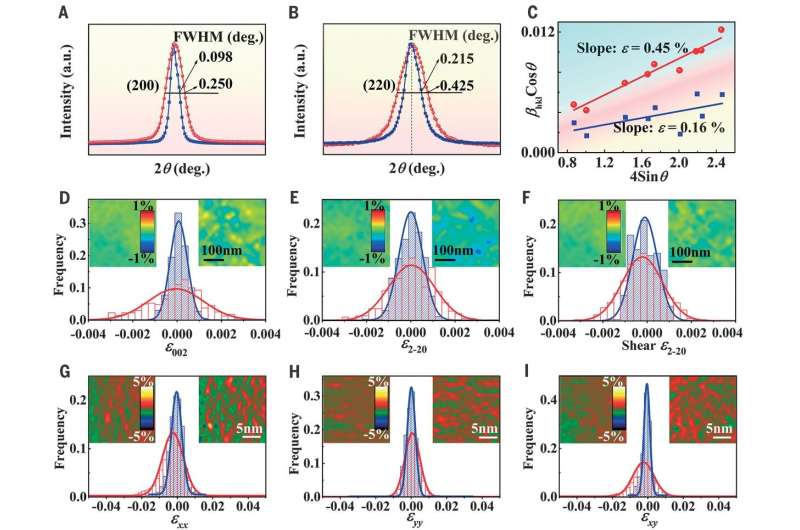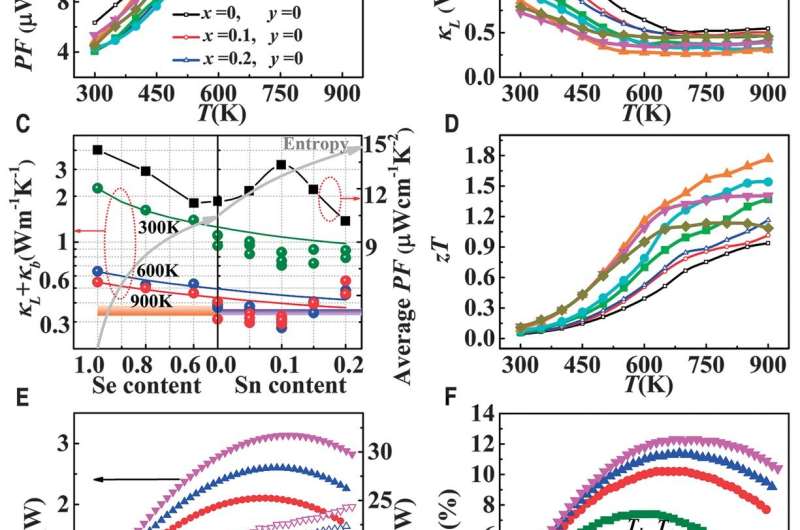Improving the performance of thermoelectric materials and modules through entropy engineering. (A) Diagram of lattice distortion with increasing entropy. The pink, red, green, blue, and purple spheres represent Pb, Sn, Se, Te, and S atoms, respectively. (B) zT values as a function of temperature for the high-entropy n-type PbSe-based materials in this work. Some reported zT values for traditional n-type PbSe-based materials are also included for comparison (38–42). (C) Maximum conversion efficiencies (hmax) as a function of temperature difference (DT) for the high-entropy segmented thermoelectric module in this work and some reported results from the literature, as indicated by the superscript [PbTe, skutterudites (SKD), and half-Heusler (HH)]. The red dashed line denotes the simulated values, the blue-shaded area indicates the previously reported results, and the inset is a photograph of the fabricated thermoelectric module. Credit: Science, doi: 10.1126/science.abe1292
Thermoelectric technology can generate electricity from waste heat, although their performance can result in a bottleneck for wider applications. Materials scientists can regulate the configurational entropy of a material by introducing different atomic species to tune phase composition and extend the performance optimization space. In a new report now on Science, Binbin Jang et al. used an n-type lead selenide (PbSe)-based high-entropy material formed by entropy-driven structural stabilization. The largely distorted lattices in the high-entropy system caused unusual shear strains to provide strong phonon scattering to lower lattice thermal conductivity. The work presents a new paradigm to improve thermoelectric performance for high-entropy thermoelectric materials using entropy engineering.
Thermoelectric technology
Materials scientists have devised technologies that can capture waste heat that result from conversion processes contributing to more than two-thirds of energy waste in the world. Thermoelectric technology is an attractive option for easy adaptation in many situations due to its small size, lack of rotating parts and gas emissions. An existing obstacle to thermoelectric technology is its low conversion efficiency. Typically, researchers can determine the energy efficiency relative to electrical conductivities and lattice thermal conductivity of thermoelectric materials. Researchers had therefore optimized the parameters by tuning band structures, microstructures and bond states with a range of proposed methods in band convergence, resonant level, alloying, nanostructure and liquid-like ions. Although named diversely, these methods generally help improve electrical transport properties and destroy the thermal transport path.
High entropy alloys (HEAs)
High entropy alloys (HEAs) typically provide a path to improve thermoelectric performance by strengthening phonon scattering based on their disorder and distorted lattice. Scientists can regulate the electronic properties of the material to maintain electron transport for use across a wide range of chemical compositions. These materials are typically defined as a solid solution containing more than five principal elements and the concept can be extended to create entropy-stabilized functional materials. Materials scientists had first reported entropy-stabilized high-entropy functional materials containing either magnesium, cobalt, nickel, copper, zinc-oxide followed by perovskites, fluorite, spinels, carbides and silicides. In any given system, when the increase in entropy is larger than that of enthalpy, the configurational entropy will increase with increasing element species, leading to a decreased Gibbs free energy and stabilized crystal structure. Researchers can also form a new phase using entropy as the driving force for performance optimization. Structures stabilized in this way, maintained free energy where the structural stabilization effect used the competition between entropy and enthalpy. Jang et al. calculated the enthalpy and vibrational entropy using density functional theory to show how the entropy-driven structural stabilization effect of a materials system formed an effective method to create diverse high-entropy materials with a composition beyond the solubility limit to provide a varied range of properties for optimized performance.
Stabilizing single-phase structure by increasing the entropy. (A) XRD patterns of PbSe-based materials with increasing S/Te and Sn content (Pb0.99−ySb0.012SnySe1−2xTexSx, where x changes from 0 to 0.25 and y changes from 0 to 0.3). The red-shaded area indicates entropy-stabilized high-entropy composition. a.u., arbitrary units. (B) Entropy, enthalpy, and Gibbs free energy as a function of S/Te and Sn content. (C to H) Shown are a (C) HAADF image along the [110] zone axis; (D) Pb, Sn, Se, and Te total EDS mapping; and (E) Pb, (F) Sn, (G) Se, and (H) Te partial EDS mapping of a high-entropy Pb0.89Sb0.012Sn0.1Se0.5Te0.25S0.25 sample. S element mapping is not shown because of the weak signal and the overlapped peak with Pb. Credit: Science, doi: 10.1126/science.abe1292
Investigating the materials
The stabilized structures maintained long-range order of atomic arrangement to form an electrical transport network. The short-range disorder in high-entropy materials caused lattice disorder to strongly scatter heat-carrying phonons that lowered the lattice thermal conductivity of the high-entropy materials, to then yield thermal transport properties with temperature difference in the thermo-electric mode. Researchers had previously noted improved thermoelectric performance across a range of high-entropy materials. However, Jang et al. remain to understand the relationship between configurational entropy, microstructure and thermoelectric properties. For example, the solubility in materials is limited due to the size and mass differences between the solute and solvent atoms, making it challenging to realize high-entropy alloys by merely increasing the alloying content. The team then studied the elemental content of the materials using X-ray diffraction (XRD) patterns and energy dispersive spectroscopy (EDS) mapping. They sought out materials with compositions beyond the solubility limit to provide a varied range for optimal performance. To further confirm the materials architecture and homogeneity, they conducted high-angle annular dark-field (HAADF) and atomic X-ray EDS analysis with scanning transmission electron microscopy (STEM). The results showed the distribution of all elements to be homogenous from the micro- to the nano-scale. Using ultra-high resolution EDS mappings, Jang et al. further clarified the atomic lattices and positions of each element, where the well-defined atomic arrangements were distinct from amorphous materials.
Strain analysis at different scales. (A and B) Enlarged (A) (200) and (B) (220) peaks of powder XRD results for a high-entropy Pb0.89Sb0.012Sn0.1Se0.5Te0.25-S0.25 sample (red). A traditional low-entropy Pb0.99Sb0.012Se sample (blue) is also included for comparison. (C) Calculated lattice strains (e) based on Williamson-Hall analysis. Statistical and spatial distribution of normal and shear strains measured by NBED and GPA. Red and blue represent the same samples as defined in (A) and (B). bhkl, the FWHM of the (hkl) peak. (D to I) Normal strains along the (D) (002) and (E) (2-20) directions and shear strains along the (F) (2-20) direction based on NBED results are shown. Normal strains along the (G) xx and (H) yy directions and shear strains along the (I) xy direction based on GPA results are shown. The blue lines and left insets are from a low-entropy Pb0.99Sb0.012Se sample. The red lines and right insets are from a high-entropy Pb0.89Sb0.012Sn0.1Se0.5Te0.25S0.25 sample. Credit: Science, doi: 10.1126/science.abe1292
Entropy-driven stabilization
During the process of entropy-driven stabilization, they achieved well-maintained atomic arrangement, but the strong mismatch of atomic size compromised the lattice to strongly affect the thermal transport process. The team measured the change of strains from low-entropy to high-entropy using samples and showed how the results tripled during the process. They then used nanobeam electron diffraction (NBED) to detect the lattice strains and investigated the strain at the atomic scale using scanning transmission electron microscopy and high-angle annular dark field (STEM-HAADF). The entropy-driven structural stabilization within the materials system worked together with the severely distorted lattice to effect electrical and thermal transport within the material. When Jang et al. later introduced tin (Sn) to a material, they retained electron stability and noted how a decreased bandgap rather than high entropy resulted in intrinsic excitation at high temperature.
Thermoelectric properties of Pb0.99−ySb0.012SnySe1−2xTexSx. x was changed from 0 to 0.25 and y from 0 to 0.2 for the samples. (A, B, and D) Temperature dependences of (A) power factor (PF), (B) lattice thermal conductivity (kL + kb), and (D) zT values. kb, bipolar thermal conductivity. (C) Composition dependence of kL + kb and average PF. The solid lines are predictions based on the alloy model. The black line represents the experimental average PF (right red arrow). The green, blue, and red circles represent experimental lattice thermal conductivity (left red arrow). The orange-purple line represents theoretical minimum lattice thermal conductivity. (E and F) Shown are (E) output power (P, left black arrow) and heat flow at the cold side (Qc, right black arrow) and (F) maximum conversion efficiency (hmax) as a function of the current (I) under different operating temperatures for the fabricated segmented thermoelectric module. Th, temperature at the hot side; Tc, temperature at the cold side. Credit: Science, doi: 10.1126/science.abe1292
Outlook
In this way, Binbin Jian and colleagues showed a method to form different high-entropy thermoelectric materials via entropy-driven structural stabilization with electrical transport properties that are well-maintained by the stabilized structure. The large strains from the severely distorted lattice in high-entropy materials provided strong scattering for heat-carrying phonons, thus to contribute to an ultralow lattice thermal conductivity. These outcomes resulted in improved functions of temperature for the high-entropy materials, alongside high thermal conversion efficiency during the experiments. The work provides insight into entropy engineering for high performance thermoelectric materials and modules as an attractive path to develop high-performance functional materials.
More information: Jiang B. et al. High-entropy-stabilized chalcogenides with high thermoelectric performance, Science, 10.1126/science.abe1292
Snyder G. J. and Toberer E.S. Complex thermoelectric materials, Nature Materials, doi.org/10.1038/nmat2090
Pei Y. et al. Convergence of electronic bands for high performance bulk thermoelectrics, Nature, doi.org/10.1038/nature09996
Journal information: Science , Nature , Nature Materials
© 2021 Science X Network
![Improving the performance of thermoelectric materials and modules through entropy engineering. (A) Diagram of lattice distortion with increasing entropy. The pink, red, green, blue, and purple spheres represent Pb, Sn, Se, Te, and S atoms, respectively. (B) zT values as a function of temperature for the high-entropy n-type PbSe-based materials in this work. Some reported zT values for traditional n-type PbSe-based materials are also included for comparison (38–42). (C) Maximum conversion efficiencies (hmax) as a function of temperature difference (DT) for the high-entropy segmented thermoelectric module in this work and some reported results from the literature, as indicated by the superscript [PbTe, skutterudites (SKD), and half-Heusler (HH)]. The red dashed line denotes the simulated values, the blue-shaded area indicates the previously reported results, and the inset is a photograph of the fabricated thermoelectric module. Credit: Science, doi: 10.1126/science.abe1292 High-entropy-stabilized chalcogenides with high thermoelectric performance](https://scx1.b-cdn.net/csz/news/800a/2021/highentropys.jpg)
![Stabilizing single-phase structure by increasing the entropy. (A) XRD patterns of PbSe-based materials with increasing S/Te and Sn content (Pb0.99−ySb0.012SnySe1−2xTexSx, where x changes from 0 to 0.25 and y changes from 0 to 0.3). The red-shaded area indicates entropy-stabilized high-entropy composition. a.u., arbitrary units. (B) Entropy, enthalpy, and Gibbs free energy as a function of S/Te and Sn content. (C to H) Shown are a (C) HAADF image along the [110] zone axis; (D) Pb, Sn, Se, and Te total EDS mapping; and (E) Pb, (F) Sn, (G) Se, and (H) Te partial EDS mapping of a high-entropy Pb0.89Sb0.012Sn0.1Se0.5Te0.25S0.25 sample. S element mapping is not shown because of the weak signal and the overlapped peak with Pb. Credit: Science, doi: 10.1126/science.abe1292 High-entropy-stabilized chalcogenides with high thermoelectric performance](https://scx1.b-cdn.net/csz/news/800a/2021/1-highentropys.jpg)
























